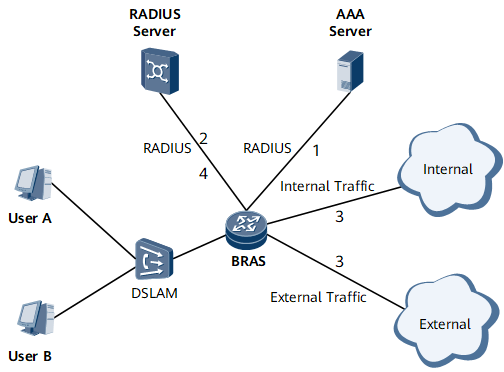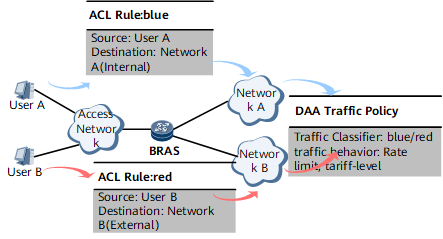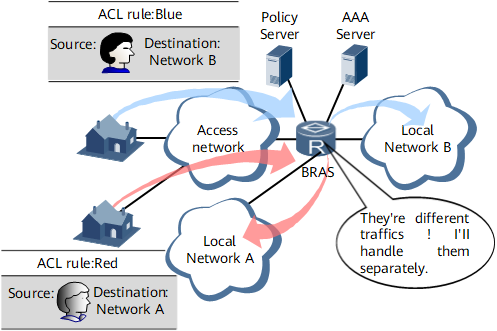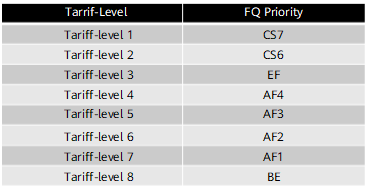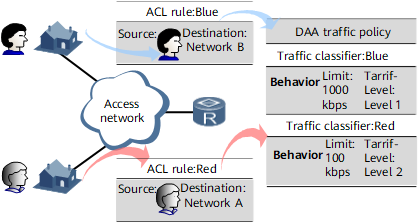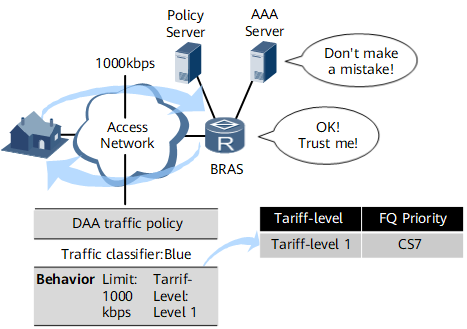Basic Concepts of DAA
Destination address accounting (DAA) is performed at different tariff levels defined based on different destination addresses of user access traffic. DAA also provides rate limit.
DAA service process as shown in Figure 1
- The user sends a login request to the BRAS. The BRAS sends a user authentication request to the AAA server. The AAA server returns a user authentication success message to the BRAS.
- The BRAS reports the user's information to the RADIUS server over RADIUS, and the RADIUS server delivers a DAA service policy to the BRAS over RADIUS. The BRAS converts the policy information, delivers the information to an interface board, and generates a service.
- When the user accesses a network, the BRAS uses an ACL to match the destination address accessed by the user, and performs independent rate limit and accounting for traffic to the local network and Internet.
- The BRAS sends an accounting stop request packet for basic services to the AAA server. The server uses the DAA service policy in the packet to identify services and provides rate limit.
DAA Service Matching Process
As shown in Figure 2, user A and user B need to access the internal and external networks, respectively. After the users are successfully authenticated and start to access the networks, the BRAS identifies user traffic based on the ACL rules. When the users access different networks, the BRAS matches the user groups and destination addresses with the ACL rules in the configured DAA service policy, and uses DAA services for differentiated management.
DAA Service Policy
DAA Service Policy contains:
DAA ACL
Packets can be matched based on the source/destination IP address, source/destination service group, source/destination user group, source/destination port number, and protocol type. Config a rule for a created user ACL. Then ACL rules can be applied to match packets.
As shown in Figure 3 , when the users access different networks, the BRAS matches the user groups and destination addresses with the access control list (ACL) rules in the configured DAA traffic policy.
Accounting mode
The accounting mode determines the type of a server that the BRAS uses for accounting. Default accounting, none accounting, and RADIUS accounting can be adopted for the value-added services.
QoS profile
QoS profile can be used to associate QoS with DAA for traffic policing and rate control. As shown in Figure 4, the tariff level maps the QoS priority, and the priority is used for scheduling.
DAA Traffic Policy
As shown in Figure 5, a DAA service policy can work with a DAA traffic policy, which is actually a specific application of a QoS traffic policy. A DAA traffic policy consists of a traffic classifier and traffic behavior, and a traffic classifier establishes a matching relationship with an ACL rule.
As shown in Figure 6, the BRAS obtains the quality of service (QoS) profile for the tariff level using the DAA service policy template. Then it uses the QoS profile to obtain CAR parameters and the mapping between tariff levels and flow queues (FQs). Based on the CAR parameters and the mapping between tariff levels and FQs, the BRAS performs rate limit and priority scheduling on the DAA service flows and gathers traffic statistics.
